The first cameras in Sony’s Alpha 7-series of mirrorless full-frame cameras were announced in October 2013 and are credited with bringing compact system cameras (CSCs) to the attention of professional photographers. Since then, they’ve proven extremely popular and helped Sony win a huge chunk of the interchangeable-lens camera market.
The Sony A7R line is the high-resolution offering, and the 42.4Mp A7R III replaces the A7R II, which itself was the replacement for the original (36Mp) A7R.
While the A7R III and A7R II have a backlit sensor with the same pixel count, the Mark III’s sensor is augmented with a front-end LSI that gives it greater processing power and a two-fold increase in the data readout speed. This, combined with the Bionz X processing engine, enables a maximum continuous shooting rate of 10fps with continuous autofocusing and metering.
Other specification highlights include a 5-axis stabilization system that Sony claims gives a 5.5 EV extension to hand-held shutter speeds, and a Pixel Shift Multi Shooting mode that creates a single composite image from four images to provide greater detail. (We made all our measurements using the standard shooting mode.)
Key specifications:
- 42.4Mp full-frame (35.9x24mm) Exmor R CMOS sensor
- Front-end LSI and Bionz X processing engine
- ISO 100–32,000 standard range for stills, expandable to 102,400
- Pixel Shift Multi Shooting for greater detail
- 3.69-million-dot OLED viewfinder
- 399 on-chip phase-detection AF points and 425 contrast-detection points
- Sony EF lens mount
Overall image sensor performance
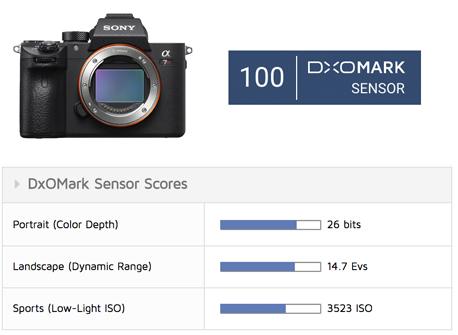
The Sony A7R III achieves an overall DxOMark sensor score of 100 points, the same as the Nikon D850. This makes it the highest-scoring mirrorless system camera to date, beating the A7R II by two points. Naturally, this means that the sub-scores are also very good, and the sensor can indeed capture wide dynamic range with good color, but it’s the Sports (Low-Light ISO) score that particularly impresses at ISO 3523. This is the fourth-highest value we’ve ever recorded — beaten only by the sensors in the medium-format Hasselblad X1D-50C and Pentax 645Z, and by the 12Mp full-frame Sony A7S II. The size and pixel count of these sensors means that the photoreceptors are in principle significantly bigger than those in the 42Mp A7R III, which gives them an advantage for light gathering and noise control.
Image quality compared
As it’s a full-frame interchangeable-lens camera with 42.4 million effective pixels, the Sony A7R III is a direct competitor to the 45.7Mp Nikon D850. It’s also going to be of huge interest to Sony A7R II users, so we’ll take a look at how the three cameras compare.

Click here to open our interactive DxOMark comparison tool
As you can see, the Nikon D850, Sony A7R III, and A7R II sensors occupy the third, fourth, and fifth slots in our scoring hierarchy. They are beaten only by the medium-format sensors in the Hasselblad X1D-50C and the Pentax 645Z, which take the first and second slots, respectively.
Although the D850’s sensor has the same overall score as the A7R III’s, it’s ranked higher because of its better Portrait (Color Depth) and Landscape (Dynamic Range) scores (we’ll look at this in more detail in the next section). In normal shooting conditions, the D850’s 0.4-bit higher Portrait (Color Depth) score is unlikely to be noticed, but it might make a slight difference in image processing. The 0.1 higher dynamic range is also so similar to the new Sony’s that in practical terms, they are the same.
While A7R III’s Sports (Low-Light ISO) score of 3523 is excellent, it’s actually only 0.4 EV higher than that achieved by the Nikon D850. So while the A7R III handles low-light situations better and produces images with less noise, the difference isn’t huge.
The most significant improvement of the A7R III’s sensor over the A7R II’s is its dynamic range (Landscape) score — 0.8 EV better, indicating that the new camera can capture a broader range of tones in a single image. That should make an appreciable difference in landscape photos.
In-depth comparisons
In this section, we’ll take a closer look at how the Sony A7R III compares with its predecessor and the Nikon D850.
Portrait (Color Depth)
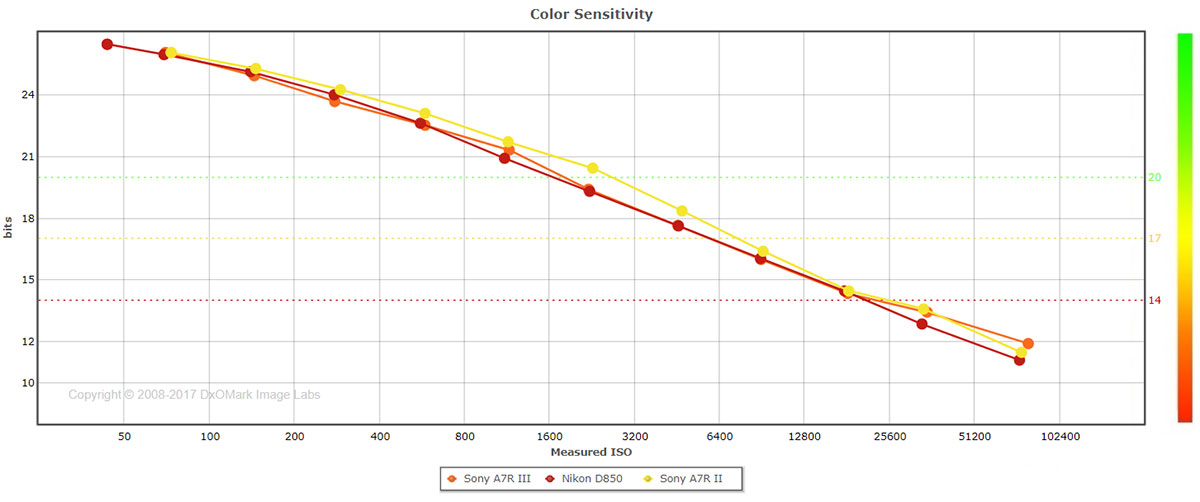
At its lowest sensitivity setting (ISO 32), the Nikon D850 sensor has a Color Sensitivity of 26.4 bits, a value that puts it on par with medium-format cameras. At ISO 50, its lowest sensitivity available setting, the Sony A7R III sensor has a Color Sensitivity of 26 bits, which is an excellent score and a close match to the D850’s at ISO 100. Above this value, the two cameras produce very similar results for the rest of their sensitivity (ISO) range.
Although the difference is unlikely to be visible in most instances, it’s interesting to see that the Sony A7R II actually beats both its successor and the D850 for Color Sensitivity for much of its sensitivity range. However, at around ISO 1600, the color sensitivity of the D850 and A7R III drops to around 20 bits. As the ISO is pushed above this value, color sensitivity continues to drop, and it will become increasingly difficult to reduce the visibility of noise without reducing color saturation when processing raw files. The A7R II sensor copes a little better, not crossing the 20-bit threshold for about another 0.7 EV.
Our tonal range results show that with the exception of the lowest ISO values, the Sony cameras record a broader range of tones. The ability to record tonal variation drops as sensitivity (ISO) rises, and the Sony camera sensors are about 0.5 EV better in this respect than the Nikon’s.
Nevertheless, landscape, portrait, still-life, and commercial photographers are likely to use as low a sensitivity setting as they can, so if they are able to drop to ISO 32 with the Nikon D850, they will be able to capture a broader range of tones. If they have to use a higher sensitivity value, the advantage is lost and in some respects, the A7R III sensor does a better job.
Landscape (Dynamic Range)
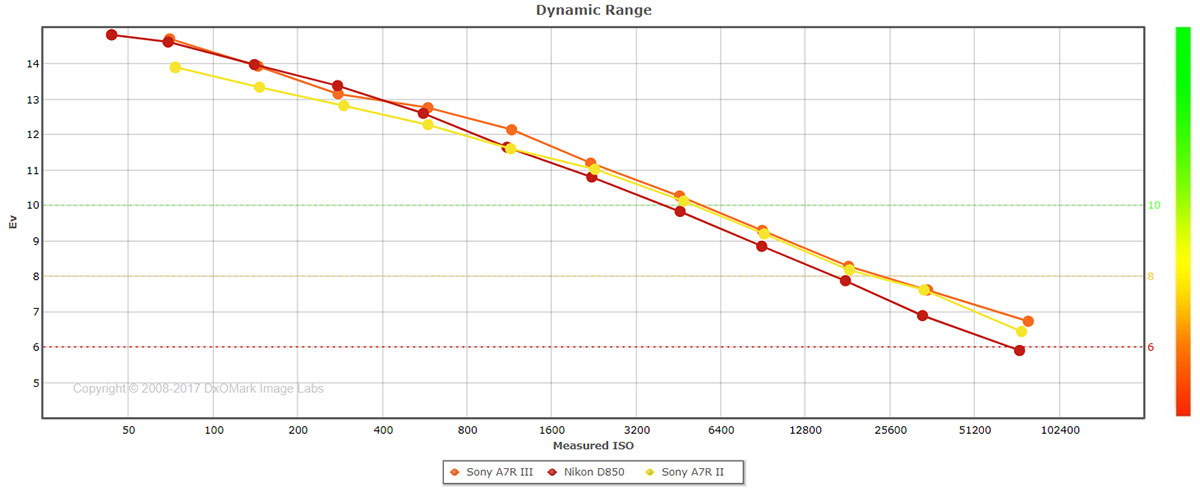
Again, the Nikon D850 benefits from its lower minimum sensitivity value that enables it to capture images with very high dynamic range. At the first few sensitivity settings above that value, however, it captures a very similar range to that of the Sony A7R III before the Sony camera takes the lead at around ISO 640. This lead of about 0.3 EV continues for the higher values, growing to around 0.7 EV by ISO 51,200.
Further good news for low-light photographers is that the A7R III’s dynamic range falls below 10 EV only at around ISO 6,400.
At high ISO values, the A7R II matches the Mark III for dynamic range, but the newer sensor shows its advantage at the lower values, from ISO 50 to 3,200 — the most commonly-used settings.
Sports (Low-Light ISO)
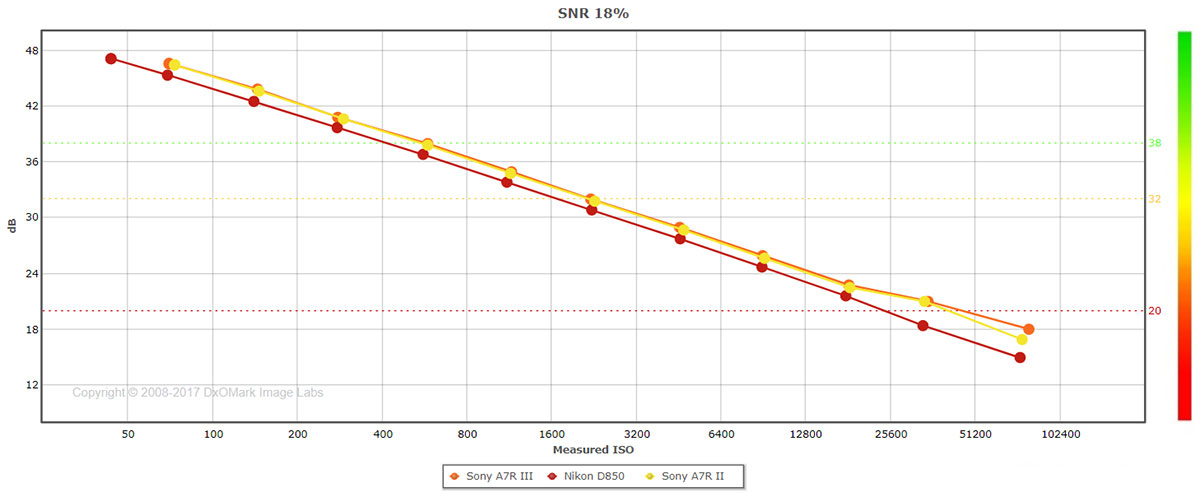
As with the Portrait (Color Depth) and Landscape (Dynamic Range) scores, the Nikon D850 achieves a higher score at its lowest sensitivity (ISO) value. Once it exceeds this value, the Sony A7R II and A7R III sensors take the lead, delivering near-identical performance that is approximately 0.3 EV better than the D850’s. By ISO 25,600, however, this lead is extended to around a stop.
The Sony A7R III sensor maintains a high signal-to-noise ratio up to a sensitivity setting of ISO 800, whereas the Nikon D850 should be kept to ISO 500 or lower.
Conclusion: Outstanding image quality in the mirrorless segment
It’s clear that the Sony A7R III has a high-performing sensor that’s capable of capturing images with a broad range of color and tone, while keeping noise well under control.
However, comparing the A7R III sensor to the Nikon D850’s reveals the advantage that the Nikon camera’s lower minimum sensitivity (ISO) value brings. Photographers who predominantly shoot in bright light or capture motionless subjects with the camera on a tripod will record the most information, be it color, tone, or detail with the Nikon D850 set to ISO 32. However, if they require values above that, the Sony A7R III sensor produces marginally better images.
Sony’s in-body 5-axis image stabilization system is widely respected, and if it achieves the 5.5 EV shutter speed compensation in the A7R III that the company claims, it would enable the camera to capture images at ISO 100 instead of at ISO 3200 (provided the subject is stationary).
In this review, we have compared the Sony A7R III sensor to its most direct rival from a different manufacturer and to its predecessor from Sony. As usual, you can create your own comparison and in-depth analysis using our interactive image sensor comparison tool.


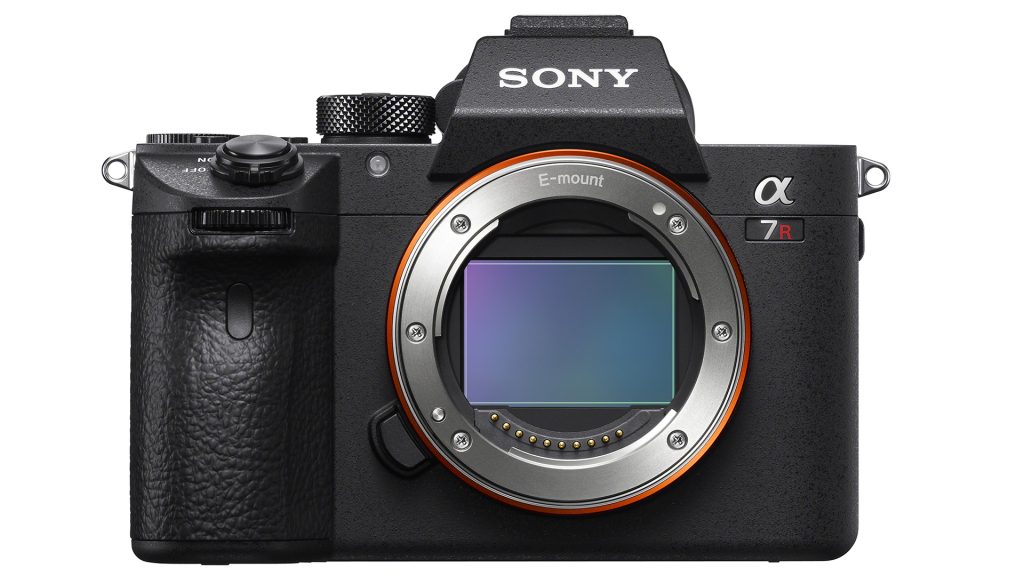




DXOMARK encourages its readers to share comments on the articles. To read or post comments, Disqus cookies are required. Change your Cookies Preferences and read more about our Comment Policy.